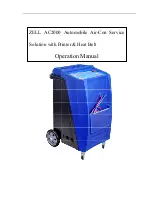
Instruction Manual | 13
10. Troubleshooting
If you notice an improper pipettor operation, identify the
cause and eliminate the fault. Follow the instructions in
the sequence provided. Replacement of parts should be
required only occasionally and should not occur under
normal pipettor use.
Problem
Cause
Solution
Droplets of
liquid remain
in the pipet
tip.
The pipet tip is
emptied too fast.
Decrease the speed
of pressing the pipettor
pushbutton.
Press the pushbutton to the
second stop to expel all the
droplets.
The pipet tip
wettability has
increased due to
extensive use.
Replace the tip with
a new one.
Droplets
of air appear
in the liquid
aspirated
into the pipet
tip.
The pipet tip
immersion
is too shallow.
Immerse the tip
deeper according to the
instructions.
The pipet tip is
incorrectly pressed
onto the pipettor
shaft.
Press the pipettor firmly.
The tip is damaged
or worn out due to
extensive use.
Replace the tip with
a new one.
The pipettor
incorrectly
aspirates
the liquid
or the liquid
drops out
from the tip.
The pipet tip is
incorrectly pressed
onto the pipettor
shaft.
Press the pipet tip firmly.
The pipettor
incorrectly
aspirates
the liquid
or the liquid
drops out
from the tip.
The shaft nut is
loose in the single-
channel pipettors
2 μL to 1,000 μL.
Tighten the shaft nut.
The sealing surface
of the shaft is
cracked or scored.
Remove the tip ejector. Unscrew
the shaft nut and inspect the
shaft and the piston assembly.
Replace the damaged parts.
When reassembling the
pipettor, the nut should be
hand-tightened. In the single-
channel pipettor model, the
damage of the shaft may also
cause a damage of the piston
assembly. Replace the damaged
parts. When reassembling the
pipettor, the nut should be
hand-tightened.







































